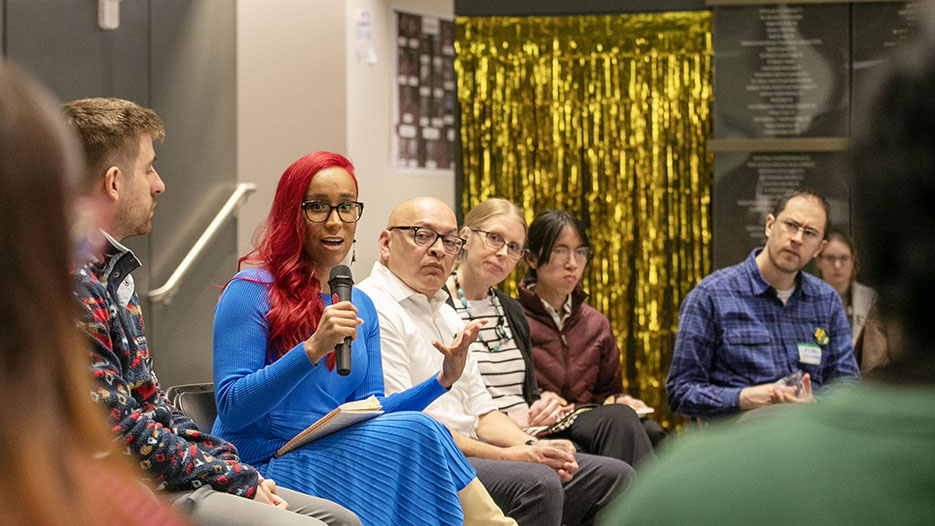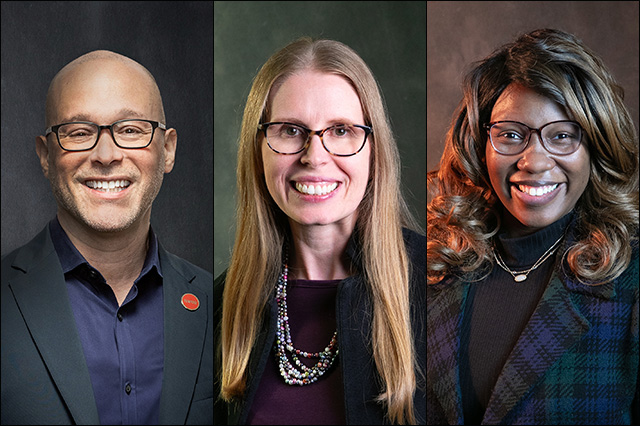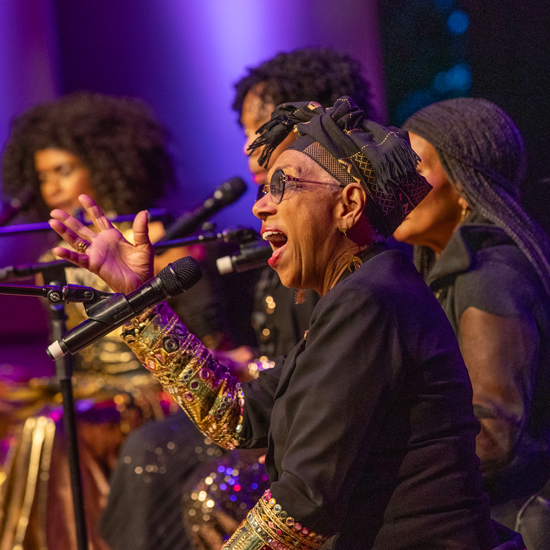True Belonging: Rediscovering the values that matter in college admissions

It all starts with admissions.
Liberal arts colleges like Skidmore depend on their admissions teams to build the best class possible each year. That means bringing the right number of students to campus to help keep the college running smoothly. It also means attracting a mix of students from many backgrounds and experiences who can build a community that will help prepare future graduates for careers in diverse workplaces and roles as citizens of the United States and countries across the globe.
It’s tough, often stressful work that sometimes comes down to the wire. Not enough students in an incoming class can spell financial hardship. Too many can leave colleges without enough seats in the classroom and a range of other challenges.
For many years, Skidmore has enjoyed an enviable position among liberal arts colleges. But institutions — including Skidmore — shouldn’t take past success for granted, as fundamental changes are radically transforming the college admissions landscape, says Ángel Pérez ’98, a Skidmore alumnus who started his admissions career at Skidmore and is now CEO of the National Association for College Admissions Counseling (NACAC), the leading trade group for admissions and college counseling professionals.
That sentiment is echoed by Jessica Ricker, Skidmore’s new vice president for enrollment and dean of admissions and financial aid, and Janessa Dunn, the College’s new director of admissions. Both are completing their first academic year at Skidmore.
Pérez, Ricker, and Dunn spoke to Scope about this new landscape and how institutions of higher education, including Skidmore, are grappling with the changes. Most prominently, the U.S. Supreme Court issued a sweeping decision last summer, in cases brought by the group Students for Fair Admissions against Harvard University and the University of North Carolina, against race-conscious admissions policies. Many institutions had long considered race among many other factors in broader efforts to ensure a representative incoming class.
But the Supreme Court ruling is only one part of the equation. Colleges, especially those in the Northeast, are bracing for major demographic shifts. Decreasing numbers of college-age students mean that institutions are dealt shrinking pools of applicants and will need to widen their reach to maintain their incoming classes.
Skidmore fully meets the demonstrated financial need of all students who are admitted, and the need for financial aid continues to grow. Two decades ago, about 44% of Skidmore students received some form of financial aid. That number now tops 55% and is only expected to increase. The rising costs associated with providing a liberal arts education further complicate the work of admissions officers.
Fortunately, Skidmore has a talented team to navigate uncertain times. But for dedicated professionals like Pérez, Ricker, and Dunn, the role and purpose of a college admissions team also extend far beyond the institutional bottom line: Ensuring that Skidmore can continue to recruit students who bring a full range of perspectives and experiences to campus is essential to fulfilling Skidmore’s very mission as a liberal arts college.
“If we were to look for a silver lining from the Harvard and UNC cases, it would be that it’s pushed us to really define what diversity means to us and why we value it,” says Ricker, who joined Skidmore in June 2023, less than a month before the Supreme Court ruling.
Certainly, diversity is not just race and ethnicity; this moment is about expanding the definition of how and why we value what we do in this residential liberal arts environment.”

From left, Ángel Pérez ’98, CEO of the National Association for College Admissions Counseling (NACAC); Jessica Ricker, Skidmore vice president for enrollment and dean of admissions and financial aid; and Janessa Dunn, Skidmore director of admissions.
Ensuring that higher education remains accessible
has defined the careers of Pérez, Ricker, and Dunn. All three say they had never considered admissions work until they entered the field through their respective alma maters, and it has since become a personal and professional calling. Drawing on the often less than ideal ways through which they found their own paths to college, they are working to ensure that prospective students representing a range of life experiences and backgrounds can enjoy the lifelong benefits associated with higher education.
Dunn, for instance, started working in the admissions office as an undergraduate at Georgia Southern University. She went on to leadership roles at Vanderbilt University and Wake Forest University, where she advanced important diversity, equity, and inclusion efforts. At Wake Forest, she led an overhaul of the application review and selection process that minimized unconscious bias across readers. A new system helped the admissions team navigate a 20% increase in applications while also creating an equity- and mission-centered review process.
Asked to summarize the goal of admissions in just a few words, Dunn defined it as “true belonging” — building a supportive community where students can learn and thrive academically, professionally, and personally.
“My journey in higher education, like many folks in this field, is that you kind of stumble upon it in some way or another,” Dunn says.
For me personally, it was having the opportunity to usher families into this new era, into this new journey, that stuck with me. I chose education because I knew that it would be a lifelong impact.”
Like Dunn, Ricker also got her start at her undergraduate college, Connecticut College, where Ricker worked in admissions for nearly two decades. She came to Skidmore from Wellesley College, where she prioritized support for historically marginalized groups, assessed implicit bias in admissions, and devised an equitable, mission-driven application review and selection process. Throughout her career, she has drawn inspiration from her own experience as a first-generation college student.
“When I was applying to schools, I had no one giving me advice aside from the school counselor who said, ‘Why aren’t you staying in Ohio?’” Ricker says.
I landed where I did because of luck and a lot of financial aid. But luck isn’t how you should decide on your college or your future — it’s such a big decision. I felt that the admissions experience should be more intentional ... To change that trajectory and help other students be more intentional is part of my why.”
That sentiment is echoed by Pérez, who came to Skidmore through the Higher Education Opportunity Program (HEOP), which celebrated 50 years last summer at Reunion.
“I love what Jess said about intentionality because my process certainly was not intentional; I was very lucky. A high school counselor tapped me on the shoulder and said, ‘Have you ever thought about going to college?’” recalls Pérez, who landed his first job in the field as an admissions counselor at Skidmore. He went on to assume vice presidential roles at Pitzer College and Trinity College-Hartford. CEO of NACAC since 2020, he supported admissions and college counseling officials throughout the nation as they navigated the exceptional tumult of the pandemic, and he has advised the Biden-Harris administration on issues of college access, affordability, and diversity.
I was a low-income student who grew up in the projects of the South Bronx and didn’t even know what Skidmore, HEOP, or the liberal arts were. It was really the interventions and support from my high school counselor, my HEOP advisor, and the Skidmore admissions office that put me on a different trajectory.”
Pérez, Ricker, and Dunn explained their work to Scope — and why it matters so much for the future of Skidmore and, most of all, students.

Skidmore’s Discovery program brings admitted students who have historically faced barriers to accessing higher education to campus each spring, so that they can acquaint themselves with academic and student life on campus.
Q&A
Q: Why is diversity important at a liberal arts college?
A: Ángel Pérez
Skidmore was the kind of place where I went to learn from people who are different from me. I always talk about the fact that I made my first Muslim friends, wealthy white friends, LGBTQ friends, and others in college. I didn’t have that exposure in my community. These kinds of encounters prepare people to live, work, and engage in a diverse society. We’re already a pretty divided nation.
I worry about the future of America if institutions of higher learning don’t maintain diversity and provide these types of experiences. There is so much research that shows that students who learn in diverse teams go on to work in diverse teams. The research also shows that diverse teams make better, stronger decisions.
As educators, our role is to prepare students for their lives after college. Students will be entering a diverse workforce, and it’s our responsibility to prepare them to live, work, and thrive in those spaces. That exposure happens and begins at Skidmore.
Q: How might the ruling affect prospective applicants?
A: Jess Ricker
This ruling is impacting young people at a time when there’s already reticence about the value of higher ed, particularly the high price tag associated with residential liberal arts colleges like ours. Prospective students from traditionally underrepresented backgrounds may be left to wonder, “Did institutions ever truly care about diversity or were they just looking at race as a checkbox on an application?” I think that’s a hard thing to hear for a community like ours here at Skidmore, where we really do care and believe in a commitment to diversity, equity, inclusion, access, justice, and belonging. Though this may sound a little bit like an alphabet soup, these are all things that we are actively working on.
In Admissions, we’re thinking about how we convey that commitment. These are issues that we care about deeply and that matter to us, our community, and to young people who are applying to college.
Q: Why is this Supreme Court decision so impactful?
A: Ángel Pérez
California’s Proposition 209 (a 1996 ballot initiative that effectively banned affirmative action in public schools in California) is an example of why we are concerned. When California as a state lost the ability to take race into consideration, the number of students of color who not only enrolled but also applied to college dropped dramatically. In fact, data show that the year after Prop 209 passed, UCLA and UC Berkeley enrolled 40% fewer black and Latinx students. The Supreme Court decision impacts everyone, including Skidmore. We will have a better understanding of the local and national implications in a few years. But if history repeats itself, we all have reason to be concerned.
The good news is that most institutions are committed to recruiting, retaining, and cultivating a diverse student body, but how that work is done is now incredibly challenging. Institutions must comply with the law and simultaneously find new and innovative ways to enroll students from all backgrounds. I’ve had the pleasure of advising the U.S. Department of Education during this year of transition. The Department is very supportive and has issued guidelines to help institutions. They are also very concerned about overcorrection. The secretary of education has made it very clear that institutions should not become so conservative in their recruitment and application evaluation processes that they inadvertently move away from their mission and values.
Q: How is Skidmore working to admit a diverse class in this time of change?
A: Janessa Dunn
I like to think in terms of assets rather than deficits. There’s a lot of literature out there that looks at the different types of capital that students bring to the table — linguistic, cultural, and more. It’s important that we appreciate and celebrate what each student brings to a residential liberal arts community like ours rather than focus on what we perceive as being missing.
To use a term that Jess has used in training with our staff, some systemic issues are often baked into high school transcripts, high school profiles, and the ways counselors and teachers are able to write about each student. And yet, I think we can look more deeply into the positive attributes that each student brings to the table.
Approaching college admissions in terms of the values that each student brings really represents a cultural shift in our line of work — and it’s not always getting a lot of attention in the media. For our students, our parents and guardians, and everyone who supports our work, it’s important that we emphasize those value-adds rather than the opposite.
Q: When we talk about diversity, do we only mean race?
A: Janessa Dunn
No. It's so much more. While the Supreme Court ruling is clear about not using race in the admissions decision process, we as an institution recognize that systemic barriers grounded in race remain in society.
President Conner launched Skidmore’s Racial Justice Initiative because our community believes it is important to contribute meaningful change on campus, in our community, and beyond. Our mission and our values, including our long-standing commitments to diversity and inclusivity, will continue to guide and inspire our actions.
A: Ángel Pérez
One thing that has changed dramatically at Skidmore — and it makes me so happy — is the amount of pride exhibited by first-generation students.
In 1994, none of us were walking around campus with an “I am first gen” T-shirt on. There really weren’t that many of us on campus at the time, and imposter syndrome was real. I’m delighted to see Skidmore’s incredible progress in this area.
For most people who were at Skidmore at the time, their family members graduated from college, and so they knew the questions to ask. They knew how to navigate certain spaces. There is a hidden curriculum in higher education, and for first-generation students, part of succeeding in college is learning it. I’m so grateful to Skidmore’s academic and student support programs for helping make the transition easier.
A lot of the work I have done in enrollment and student success has focused on helping students navigate the admissions process and then creating support systems to ensure their success on campus.
It’s essential that we help all students uncover that hidden language of college and set them up for success. I believe all three of us — Jess, Janessa, and I — have dedicated our lives to doing just that.
A: Jess Ricker
Our commitment to racial justice is an important value for us at Skidmore. At the same time, diversity encompasses many attributes of our students’ identities. Being a first-generation college student, for instance, is an identity that is often less visible.
As a first-gen student, I didn’t know about what Ángel calls the hidden curriculum of higher education — the unwritten rules that students use to navigate college. We need to do things that help everyone succeed.
It’s taken a while for us in higher education to figure out how to support intersectional identities — being first gen and being low income; being first gen and being a student of color; being first gen and international. There are different ways that students need support, depending on their background and identities.
Q: What is the role of college application essays following the Supreme Court ruling?
A: Jess Ricker
Some institutions have decided to add additional essays so students can talk about their lived experiences. At Skidmore, we thought long and hard about that.
We decided that we didn’t want to add additional hurdles to an already stressful and confusing process.
Students may be thinking, “Am I allowed to say this? What are institutions allowed to hear? Does this mean that I need to take my lived experience, my race or ethnicity, for example, and tell a narrative of resilience in my essay?”
I’d much rather have a student’s essay be a celebration of whatever it is they are passionate about and want to share within their college application. This moment has made it more urgent for us to communicate how our values tie into the admissions process and what we do.
A: Janessa Dunn
I’m not afraid of this new change. I am also very excited and invigorated by it. Some of my personal motivation comes from growing up in a highly segregated city, in a highly segregated state, and having to navigate those systems over and over again.
It’s exciting to know that we now have the opportunity to build practices that stem from our own mission and values here at Skidmore and to do so in a way that will affect generations to come. It is laborious work but also exciting work.
Q: How does the newly announced partnership with QuestBridge support Skidmore’s efforts?
A: Janessa Dunn
Skidmore has a long history of identifying and supporting talented students who otherwise wouldn’t have us on their radar.
We have the very successful Opportunity Program and other programs, such as S3M (Skidmore Scholars in Science and Mathematics scholarship) and our annual Discovery Tour, which brings admitted students who have historically faced barriers to accessing higher education to campus each spring.
QuestBridge is unique in that it offers prospective students the opportunity to come together and learn about the entire process of going to college. It builds community and connection at a time when students are seeking relationships and guidance that can transform their lives — and deepen their understanding of postsecondary education. The positive momentum that this exciting new partnership will provide just can’t be underestimated.
Q: What other challenges do colleges face?
A: Jess Ricker
The cost of tuition, room, and board is rising much faster than family incomes, and inflation has made it even more difficult for families to afford college. The microgeneration emerging from the pandemic is certainly reticent about loans and debt. In addition, there are important changes in the United States — the population of high school graduates is shrinking, and they will increasingly be living in states outside of the Northeast, places where Skidmore has less brand recognition and awareness of who we are.
A: Ángel Pérez
I don’t want the Skidmore community to read this article and say, “Skidmore should just recruit in Texas more and that’ll solve all your problems.” That’s not how it works.
There are fewer 18-year-olds in the United States, and that makes it very challenging to fill seats in colleges. There are also fewer families who can afford the price tag. The fastest-growing population of students in America are low-income, first-generation students. That’s a beautiful thing, but it’s also challenging because it means students will need a lot of financial aid to attend colleges like Skidmore.
The future of the College’s success will depend on its ability to build a strong endowment for financial aid.
Q: Why is college so expensive?
A: Ángel Pérez
Leaders of small, residential liberal arts colleges run a small city 24 hours a day. Schools feed students, educate them, provide housing, and cater to their every need as they develop in college.
They also have a very talented workforce with the highest degrees in their fields who require competitive wages.
The cost of running a physical plant goes up each year, and the kind of high touch experiences students receive are very expensive propositions. Did I mention inflation?
There is very little subsidy from the government for higher education, particularly for private institutions. Therefore, private institutions depend primarily on tuition and secondarily on donations to fund their operations. The pressure that these institutions feel is tremendous, and it’s not going to get any easier.
Q: How can alumni support Skidmore?
A: Ángel Pérez
Time, talent, and treasure: When Skidmore says we need you, step up to the plate. Share your talents with Skidmore. As a community, we are a powerful collective and have much to contribute.
Most importantly, don’t forget to include Skidmore in your philanthropic plans. So many Skidmore alums, my close friends included, are doing so well. They have built incredible lives as a result of the education they received. It’s time to give back. Skidmore is going to need the support so the next generation also has opportunity.
Finally, speak well of the College — that’s free, and it’s easy. Share your stories and your love for Skidmore because those are the kinds of things that translate into students becoming interested and students enrolling.
There’s a huge opportunity to galvanize Skidmore’s alumni around these issues. Alumni might read articles in the media about the challenges facing higher education, but they don’t always connect the dots and realize that these national issues are also front and center for their alma mater.
Learn more on Skidmore College's Admissions and Aid website. This article first appeared in the spring 2024 issue of Scope magazine.


